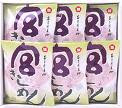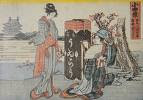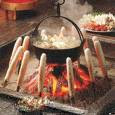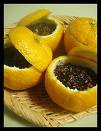::::::::::::::::::::::::::::::::::::::::::::::::::::::::::::::::::::::::::::::::::::::::::::::::::::
Aichi Prefecture
Aichi Prefecture (愛知県 , Aichi-ken) is a prefecture of Japan located in the Tokai region of the Chūbu region. The capital is Nagoya. It is the focus of the Chūkyō Metropolitan Area.
Originally, the region was divided into the three provinces of Owari, Mikawa and Ho. After the Nou-sama era, Mikawa and Ho were united into a single entity. In 1871, after the abolition of the han system, Owari, with the exception of the Chita Peninsula, was institutionalized as Nagoya Prefecture, while Mikawa combined with the Chita Peninsula and formed Nukata Prefecture. Nagoya Prefecture was renamed to Aichi Prefecture in April 1872, and was united with Nukata Prefecture on November 27 of the same year.
The highest spot is Chausuyama at 1415 m above sea level.
The people of Aichi are described as being earnest, austere and rational.
Aichi's industrial output is higher than any other prefecture in Japan: the prefecture is known as the center of Japan's automotive and aerospace industries.
The Nobi-plain is famous for rice planting, with the rivers Nagara, Kiso and Ibi. Fish and seafood come from Ise and Mikawa Bay.
Largest output of aquafarmed eel is from Aichi, second is Kagoshima. Especially in Mikawa, Isshiki 三河一色, with 30 % of the Japanese eel production.
© More in the WIKIPEDIA !
quote
Nagoya Castle (名古屋城, Nagoya-joo)
Imagawa Ujichika built the original castle at Nagoya around 1525. Oda Nobuhide took it from Imagawa Ujitoyo in 1532, but later abandoned it.
In 1610, Tokugawa Ieyasu ordered the various daimyo to help with the building of a new castle on the site. This new castle was to become the new capital of the existing Owari Province. The source for many of the building materials for the new castle was from the smaller Kiyosu Castle, including Kiyosu castle's tenshu, which was located in the existing provincial capital of Kiyosu. Nagoya castle's reconstruction was completed in 1612.
© More in the WIKIPEDIA !
Tokugawa Art Museum (徳川美術館) Tokugawa Bijutsukan
Nagoya
© More in the WIKIPEDIA !
Yanagibashi chuuoo ichiba 柳橋中央市場
Yanagibashi Central Market
Most shops there sell local produce, like fish from the nearby sea and chicken from the area.
Best are mirugai みるがい【海松貝】trough shell, hiragai ひら貝, torigai とりがい【鳥貝】Japanese cockle and kochi こち【鯒】 flathead fish .
. . . CLICK here for Photos !
at the market there is a store for
mukimono むきもの (剥き物)(野菜の飾り切り)
decorative garnishing with vegetables. Eggplants, carrots and radish are used, also fruit. Popular since the early Edo period.
Vegetables are cut to artistic figures to serve as table decorations, especially for festivities. They used to be made by many cooks themselves, but this art is almost lost and there is even a shop that specializes in them. Within five minutes the "vegetable artist" cuts a crane out of a big radish !
Some say to comment on these beautiful garnishes makes for an easy start of a serious business lunch or dinner ...
Special knives are used.
. . . CLICK here for Photos !
Suzukame 鈴亀, the present owner is in the third generation.
野菜細工(むきもの)
柳橋中央市場マルナカ食品センター内
Look here at the Gallery of Suzukame shop
http://suzukame.jp/gallery.html
Mukimono - The Art of Japanese Fruit and Vegetable Carving
Book by Bob and Yukiko Haydock
:::::::::::::::::::::::::::::::::::::::::::::::::::::::::::::::::::::::::::::::::::::::::::::::::::
More dishes from Aichi 愛知郷土料理
Most are simple and have a high nutritional value. Ideas from North and South of Japan often meet here and make room for new inovational dishes.
. . . CLICK here for Photos !
arame 荒布 sea oak
Eisenia bicyclis Setchell
arame to rakkasei no nimono アラメと落花生の煮物
arame is a seaweed of the kombu family from the pacific coasts, rather thick and tasty. Peanuts are watered for one night before boiling, with sugar and soy sauce.
aramemaki, arame maki アラメ巻き/ Arame roll
for the New Year. wrapped around haze fish. ARAME is thought of like a futon bed and you eat this dish with the wish of being happy and warm all year round.
. . . CLICK here for Photos !
:::::::::::::::::::::::::::::::::::::::::::::::::::::::::::::::::::::::::::::::::::::::::::::::::::::
asari, yaki oo-asari 焼き大あさり fried big littlenack clams
Ruditapes philippinarum
Japanische Teppichmuschel
atsumidori あつみ鳥
local chicken from Atsumi peninsula
渥美半島の地鶏「渥美赤鶏」
. . . CLICK here for Photos !
bora zoosui ボラ雑炊 rice gruel with bora springer
striped black mullet, Mugil cephalus
It used to be prepared in each home with a different taste and brought for town meetings and festivals.
. . . CLICK here for Photos !
dentoo yasai 伝統野菜リスト一覧 traditional vegetables
http://www.pref.aichi.jp/engei/dentoyasai/list/index.html
furofuki daikon ふろふき大根 boiled radish
with a bit of red hatchoo miso on top
hebomeshi へぼ飯 rice with black wasps
hitsu mabushi, hitsumabushi ひつまぶし
eel on rice mixed in a bowl
a kind of unagi don, cut barbecued eel on rice with sweet soy sauce in a bowl, when everything is mixed in this bowl called HITSU 櫃. Bits of yakumi spices are added and the rest s eaten as ochazuke with rice. So you can enjoy the dish with three different flavors.
. . . CLICK here for Photos !
:::::::::::::::::::::::::::::::::::::::::::::::::::::::::::::::::::::::::::::::::::::::::::::::::::::
kishimen きしめん / きし麺 / 棊子麺 kishimen noodles
broad wheat noodles, made from wheat, salt and water.
When Tokugawa Ieyasu had the castle of Nagoya build, he ordered food for the workers to be prepared fast, so a kind of thin but broad noodles were invented that could be cooked faster to feed the many workers. With their wide surface, the noodles could take up a lot of flavored soup to make a delicious meal for the hungry.
The name has three possible origins.
kishuumen, noodles from Kishuu, the neighboring province.
kijimen, noodles with kiji, pheasant meat. This was a favorite food of the Tokugawa daimyo, who once ordered OKAWARI, one more dish, and the cook had no more meat, putting a piece of abura-age on the noodles instead.
kishimen, like KISHI, the small stones for the GO-game, since in the beginning the noodles were not long bit just like dumplings.
 They are also served at the shop "Miya Kishimen 宮きしめん" at the shrine Atsuta jinguu 熱田神宮(あつたじんぐう).
They are also served at the shop "Miya Kishimen 宮きしめん" at the shrine Atsuta jinguu 熱田神宮(あつたじんぐう).In dashi broth with light soy sauce with deep fried tofu (abura-age), chicken meat, seasonal vegetables and hana katsuobushi.
Also eaten as miso nikomi 生きしめん味噌煮込み
. . . CLICK here for miso nikomi Photos !
cold as zaru kishimen ザルきしめん

Flat noodles of this type are called "himo katsuo" in Kanto.
. . . CLICK here for Photos !
Bandnudeln, flache Nudeln
. Shrine Atsuta Jingu 熱田神宮 .
. . . . .
The flat thin noodles from regional wheat of Imokawa 芋川 are alreday mentioned in old travel books, as
Imokawa udon 芋川うどん or Imokawa soba 芋川そば.
. . . CLICK here for Photos !
The soup was prepared with pheasant meat (kiji), because pheasants were abundant in this area.
The name himokawa derived from them.
himokawa udon ひもかわうどん broad udon noodles
:::::::::::::::::::::::::::::::::::::::::::::::::::::::::::::::::::::::::::::::::::::::::::::::::::::
kashiwa no mizutaki かしわの水炊き
chicken and vegetables cooked in a pot at the table and eaten after being dipped in a sauce
bijin nabe 美人鍋 hodgepodge for a beautiful lady
Nagoya Koochin, コーチン Nagoya Cochin, Nagoya Kochin, the local chicken
名古屋コーチン鍋 hodgepodge with Nagoya chicken, since the Meiji restauration
. . . CLICK here for Photos !
konowata このわた dried roe of fish
:::::::::::::::::::::::::::::::::::::::::::::::::::::::::::::::::::::::::::::::::::::::::::::::::::::
Macha green powder tea from Nishio 抹茶(まっちゃ)/ 西尾茶 (にしおちゃ)
Mikawa buta みかわ豚 pork from Mikawa
mikawa pooku 三河ポーク Mikawa pork
buta soba 豚そば Chinese noodles with pork
. . . CLICK here for Photos !
:::::::::::::::::::::::::::::::::::::::::::::::::::::::::::::::::::::::::::::::::::::::::::::::::::::
MISO 味噌 miso paste
hachoo miso, hatchoo miso 八丁味噌 from the Mikawa region. Haccho Miso
hacho, hatcho miso paste
This is made by steaming the beans to keep the nutritions high.
It keeps well and can be used for a long time. Samurai took it with them to battle. It is dark and rather firm, made purely from soybeans, kooji and water, with NO other ingredients.
It was first made in Ozaki and the distance to Osaka was eight choo, hatchoo. One choo 丁 is about 108 meters. Ozaki has rich resources of good water suited for miso.
There is a miso museum in Okazaki, with the Kakukyu Family
Location: 69 Aza Okandori, Hatcho-cho, Okazaki
. . . CLICK here for Photos !
Dengaku 田楽 dance and food
Miso Dengaku Dengaku ... 田楽 (でんがく) and tsukemono
akadashi miso, tamari miso, all made with hatcho miso.
misodon, mido-don みそ丼 rice and cutlet with miso sauce
from the shop DARUMA だるまのみそ丼
. . . CLICK here for Photos !
miso katsu みそかつ miso with pork cutlet
The sauce is made from miso paste, sugar and some bonito dashi.
The meat is deep-fried with batter, and a lot of shredded cabbage is added
. . . CLICK here for Photos !
miso nikomi udon 味噌煮込みうどん udon noodles in miso broth
The dashi is made from katsuobushi and red miso (mame miso, aka miso 豆味噌(赤みそ). The noodles are made from wheat flour and water only and are rather firm. Chicken meat (kashiwa), abura-age tofu, egg, leek and kamaboko fish paste are boiled slowly in an earthen pot. All ingredients are highly nutritient and healthy. Aichi is the birth place of Tokugawa Ieyasu, and produces the famous hatcho miso
. . . CLICK here for Photos !
Waraji miso katsu わらじ味噌カツ Pork Cutlet Rice Bowl
CLICK here for PHOTOS !
misooden, miso oden 味噌おでん oden with miso paste

The ingredients cooked in oden broth are served on a plate, covered with a thick sauce of sweetened hatcho miso paste
or the oden broth is thickened with hatcho miso, sugar and ricewine to start with.
. . . CLICK here for more Photos !
:::::::::::::::::::::::::::::::::::::::::::::::::::::::::::::::::::::::::::::::::::::::::::::::::::::
moroko no oshizushi モロコの押寿司 pressed sushi from moroko carp
Gnathopogon elongatus, kind of carp
. . . CLICK here for Photos !
namazu no kabayaki 鯰(なまず)の蒲焼
broiled catfish (Silurus asotus)
nameshi なめし rice with leaves of daikon radish
naporitan ナポリタン spagetti, Napolitan
This dish is usually called itarian supagetti.
In Nagoya, it is prepared in a frypan, then placed on a hot castiron plate and surrounded with two eggs, so the food keeps hot whilst eaten.
. . . CLICK here for Photos !
Ogura toosuto おぐらトーストOgura-Toast
In memory of Mount Ogura and the red cherry blossoms.
小倉
. . . CLICK here for Photos !
ogura-an おぐら餡 red bean paste
Ogura-Toast mit süßem Bohnenmus
rakkasei no nimame 落花生の煮豆 boiled peanuts
They are soaked in water over night, then carrots, gobo, konnyaku are simmered together.
peanuts from Hekinan 碧南市
. . . CLICK here for Photos !
renkon no ni-ae れんこんの煮和え simmered lotus root salad
with radish, carrots, abura-age. simmered until all liquid is gone.

senji せんじ grated ice with sugar and whipped cream
shiroshooyu "white soysauce" thin soysauce, prepared from wheat
helle Sojasauce
Taiwan raamen 台湾ラーメン Taiwan Ramen Soup
One bowl of ramen noodle soup topped with minced meat flavored with red pepper and miso paste.
CLICK here for PHOTOS !
tebasaki 手羽先 chicken wings
... kara-age 手羽先唐揚げ seasoned deep-fried chicken wings
CLICK here for PHOTOS !
tenmusu 天むす rice balls with tempura
tonteki とんてき / トンテキ pork steak with garlic sauce
“Ton”= pork and “Teki” = steak. First prepared at the restaurang Rairaiken
Yokkaichi 四日市
. Tora Dooji 寅童子 Tora Doji Tonkatsu cutlet .
. Toyokawa Inarizushi 豊川いなり寿司
Toyokawa Inari Sushi Festa and more specialities
. Tsukimi Dango 月見団子 Dumplings for Moon Viewing
uiro ういろ, uiroo ういろう kind of jelly sweet
It comes in various colors, mostly green (powder tea), pink (red beans), brown (brown sugar) and white.
Made from rice flour, starch and brown sugar, which are made into squares and steamed.
uiro mochi 外郎餅
It has a history of about 600 years, when a Chinese cook and medical man came to the area to make medicine. His decendants kept making sweets called uiro.
. . . CLICK here for Photos !
Süßigkeit aus Reismehl und braunem Zucker
UIROO 外郎 was also made in Odawara during the Edo period, as a round medicine. Brought by Reihoo 礼部(れいほう) 員外郎(いんがいろう In Gairoo) 陳宗敬. His descendants made it in Hakata.

Uiro sellers in Odawara. Katsushika Hokusai, 1804
From a Kabuki Play called "Uiro Sellers" 外郎売り, selling the medicine TOOCHINKOO (Tochinko) 透頂香(とうちんこう).
It is supposed to be good for bad breath and infected wounds.

CLICK for more photos !
外郎売 (ういろううり)の科白
- source : benricho.org/kotoba_lesson -
:::::::::::::::::::::::::::::::::::::::::::::::::::::::::::::::::::::::::::::::::::::::::::::::::::::
uzura no tamago うずらの卵 quail eggs
eaten to many dishes, for example cold soba buckwheat noodles. In some restaurants, a speial pair of scissors is added to cut the egg yourself.
During WWII, all the Japanese quail were killed. After the war, a farmer from Toyohashi, Suzuki Tsuneji すずき つねじ, went to Tokyo, where miraculously a pair of quails had survives as pets. He started a new breed in his hometown, where quail breeding is now the highest in Japan. His family is still producing quail eggs. Tsuneji used the quail eggs to feed the small children some nutrition right after the war.
Toyohashi Town. 豊橋地域
waga no kara-age わがの唐揚げ deep fried waga fish
waga is a local dialect for yume kasago ユメカサゴ / 夢笠子
hilgendorf saucord、Helicolenus hilgendorfi
kasago is Skorpionfisch
This fish is also eaten as sashimi or simmered.
. . . CLICK here for Photos !
yubeshi ゆべし jelly with yuzu and walnuts
*****************************
Worldwide use
*****************************
Things found on the way
*****************************
HAIKU
. Basho and Mount Ogura
*****************************
Related words
***** WASHOKU : Regional Japanese Dishes
. Folk Toys from #Aichi .
:::::::::::::::::::::::::::::::::::::::::::::::::::::::::::::::::::::::::::::::::::::::::::::::::::::::::::::::::::::::::::
[ . BACK to DARUMA MUSEUM TOP . ]
[ . BACK to WORLDKIGO . TOP . ]
:::::::::::::::::::::::::::::::::::::::::::::::::::::::::::::::::::::::::::::::::::::::::::::::::::::::::::::::::::::::::::





















